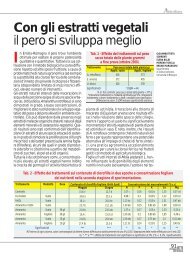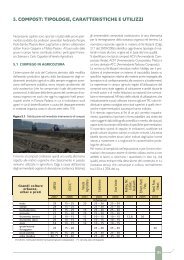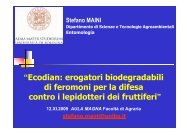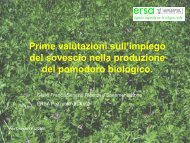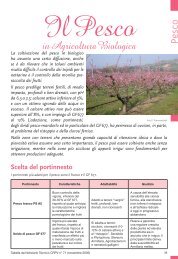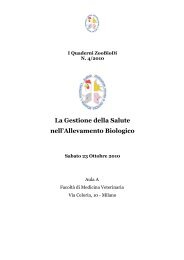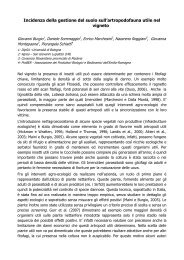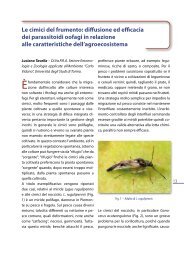You also want an ePaper? Increase the reach of your titles
YUMPU automatically turns print PDFs into web optimized ePapers that Google loves.
Petria 20 (1), 1-72 (2010) – Atti Convegno - Ancona, 26 Febbraio/February 2010- efficacia a bassi dosaggi 50-70 g/hl Cu ++ (Egger et al., 2004; Bergamaschi etal., 2006);- particelle fini ed omogenee (1,5 µm) per una migliore copertura dellavegetazione;- pH neutro a garanzia di elevata selettività e miscibilità con la maggior partedegli agrofarmaci (Delaiti e Sandri, 2005);- formulazione brevetta in granuli idrodisperdibili Disperss;- presenza del sale di rame più stabile, brocantite (idrossisolfato di rame) chelibera una quantità di rame tra le più basse (ma efficace), con un’eccellenteselettività.Parole chiave: Efficacia, Rame, Selettività, Solubilizzazione.Hydroxy copper sulphate: an innovation technologyto reduce copper ratesUp to the 1960’s, Bordeaux mixture (BM) was made by the farmers, withcopper sulphate and the addition of a little amount of lime-wash solution, withcontinuous stirring. The reaction process was checked with a strip sodden withphenophthalein. The lime-wash addition ended when the strip turned red and the productbecame blue. The final product showed an alkaline pH, an aleatory granulometry,and low effectiveness, and it had to be sprayed at high dose rates. From the 1950’s,the chemistry of BM developed, and the first industrial productions were obtained.pH and crystallization controls optimized the correct amounts of copper sulphateand lime. From 1960 to 1980, different production methods were tested: “direct”,“inverse” and “American”. Nevertheless, there was still uncertainty concerning thefinal product, and this was reflected in an empirical definition of BM that was basedon a manufacturing process, instead of being based on a precise chemical composition.The following definition is still used (ACTA, 2003): “A tank mixture with or withoutstabilizers of copper sulphate and lime”. This defines BM as a mixture of differentsalts with variable properties.Poltiglia Disperss is the result of research carried out to optimize themanufacturing procedure of the technical product, calibrating the reaction parametersand avoiding the creation of the numerous saltern forms that negatively affect the finalperformance of the product against plant diseases. The setting up of this new methodpermitted a final product to be obtained that was composed of only brocantite (copperhydroxy sulphate) and plaster, with an optimized granule size. Copper works againstthe fungal diseases in the form of the Cu 2+ ion, and thus the two main aspects thatinfluence the solubilisation of copper salts have been studied: the thermodynamicsand kinetics (Morel, 1991; Stum and Morgan, 1996; Ferrier et al., 2003). The formerinvestigates the solubilisation of the copper salt in relation to pH modifications, thelatter quantifies the amount of soluble copper in relation to the leaching. Those two30



